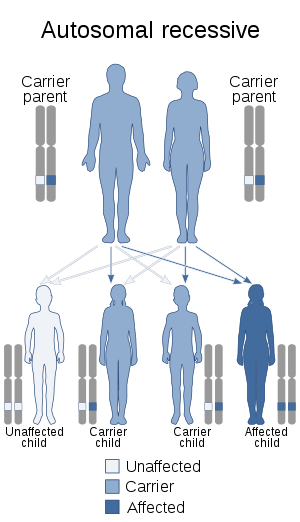D-glycerate dehydrogenase deficiency
D-glycerate dehydrogenase deficiency or PHGDH is a rare autosomal metabolic disease where the young patient is unable to produce an enzyme necessary to convert 3-phosphoglycerate into 3-phosphohydroxypyruvate, which is the only way for humans to synthesize serine.
| D-glycerate dehydrogenase deficiency | |
|---|---|
| Other names | 3-phosphoglycerate dehydrogenase |
 | |
| Condition is acquired via an autosomal recessive pattern | |
| Specialty | Metabolism |
| Symptoms | Congenital microcephaly, psychomotor retardation and seizures in infants, moderate developmental delay and behavioral disorders juveniles.[1] |
| Usual onset | Adolescent, Infancy, Childhood |
| Causes | Genetic |
| Prevention | N/A |
| Treatment | Diet |
| Medication | Serine |
| Prognosis | Shortened life expectancy |
| Frequency | <1 / 1 000 000 |
This disorder is called Neu-Laxova syndrome in neonates.
Symptoms and signs
In addition significantly shortening lifespan, PHGDH deficiencies are known to cause congenital microcephaly, psychomotor retardation, and seizures in both humans and rats, presumably due to the essential signaling within the nervous system that serine, glycine, and other downstream molecules are intimately involved with.
Cause
Homozygous or compound heterozygous mutations in 3-phosphoglycerate dehydrogenase (PHGDH) cause Neu-Laxova syndrome[2][3] and phosphoglycerate dehydrogenase deficiency.[4]
Mechanism
3-Phosphoglycerate dehydrogenase catalyzes the transition of 3-phosphoglycerate into 3-phosphohydroxypyruvate, which is the committed step in the phosphorylated pathway of L-serine biosynthesis. It is also essential in cysteine and glycine synthesis, which lie further downstream.[5] This pathway represents the only way to synthesize serine in most organisms except plants, which uniquely possess multiple synthetic pathways. Nonetheless, the phosphorylated pathway that PHGDH participates in is still suspected to have an essential role in serine synthesis used in the developmental signaling of plants.[6][7]
Diagnosis
Treatment
Treatment typically involves oral supplementation of serine and glycine.[8][9]
References
- "Orphanet: Search by disease name". Retrieved 1 December 2019.
- Shaheen R, Rahbeeni Z, Alhashem A, Faqeih E, Zhao Q, Xiong Y, Almoisheer A, Al-Qattan SM, Almadani HA, Al-Onazi N, Al-Baqawi BS, Saleh MA, Alkuraya FS (Jun 2014). "Neu-Laxova syndrome, an inborn error of serine metabolism, is caused by mutations in PHGDH". American Journal of Human Genetics. 94 (6): 898–904. doi:10.1016/j.ajhg.2014.04.015. PMC 4121479. PMID 24836451.
- Acuna-Hidalgo R, Schanze D, Kariminejad A, Nordgren A, Kariminejad MH, Conner P, Grigelioniene G, Nilsson D, Nordenskjöld M, Wedell A, Freyer C, Wredenberg A, Wieczorek D, Gillessen-Kaesbach G, Kayserili H, Elcioglu N, Ghaderi-Sohi S, Goodarzi P, Setayesh H, van de Vorst M, Steehouwer M, Pfundt R, Krabichler B, Curry C, MacKenzie MG, Boycott KM, Gilissen C, Janecke AR, Hoischen A, Zenker M (Sep 2014). "Neu-Laxova syndrome is a heterogeneous metabolic disorder caused by defects in enzymes of the L-serine biosynthesis pathway". American Journal of Human Genetics. 95 (3): 285–93. doi:10.1016/j.ajhg.2014.07.012. PMC 4157144. PMID 25152457.
- Jaeken J, Detheux M, Van Maldergem L, Foulon M, Carchon H, Van Schaftingen E (Jun 1996). "3-Phosphoglycerate dehydrogenase deficiency: an inborn error of serine biosynthesis". Archives of Disease in Childhood. 74 (6): 542–5. doi:10.1136/adc.74.6.542. PMC 1511571. PMID 8758134.
- "MetaCyc L-serine biosynthesis". biocyc.org. Retrieved 2016-03-01.
- Ros R, Muñoz-Bertomeu J, Krueger S (Sep 2014). "Serine in plants: biosynthesis, metabolism, and functions". Trends in Plant Science. 19 (9): 564–9. doi:10.1016/j.tplants.2014.06.003. PMID 24999240.
- Ho CL, Noji M, Saito M, Saito K (Jan 1999). "Regulation of serine biosynthesis in Arabidopsis. Crucial role of plastidic 3-phosphoglycerate dehydrogenase in non-photosynthetic tissues". The Journal of Biological Chemistry. 274 (1): 397–402. doi:10.1074/jbc.274.1.397. PMID 9867856.
- de Koning TJ, Duran M, Dorland L, Gooskens R, Van Schaftingen E, Jaeken J, Blau N, Berger R, Poll-The BT (Aug 1998). "Beneficial effects of L-serine and glycine in the management of seizures in 3-phosphoglycerate dehydrogenase deficiency". Annals of Neurology. 44 (2): 261–5. doi:10.1002/ana.410440219. PMID 9708551.
- de Koning TJ, Klomp LW, van Oppen AC, Beemer FA, Dorland L, van den Berg I, Berger R (2004-12-18). "Prenatal and early postnatal treatment in 3-phosphoglycerate-dehydrogenase deficiency". Lancet. 364 (9452): 2221–2. doi:10.1016/S0140-6736(04)17596-X. PMID 15610810. S2CID 40121728.